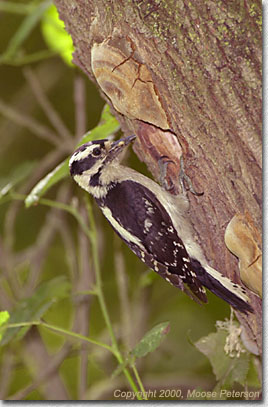|
|
 Photo Tip... Knowing the Subject Text and Photography Copyright Moose Peterson
There are two references I can highly recommend that Iíve been using for a long time. The first is A Guide to the Nests, Eggs, and Nestlings of North American Birds by Paul Baicich and Colin Harrison (ISBN# 0-12-072831-1). The other is Thayer Birding Software , Birds of North America v2.5. These two resources should be on every bird photographerís shelf and CD Drive! Whether youíre totally new to birds or have been doing it for twenty years like myself, they can provide you an incredible wealth of info! When it comes to nesting birds, do you ever wonder what time of year they nest or if they build their nests in trees, shrubs or on the ground? Or how many eggs they lay, how long they incubate or whether incubation is shared or done by just one parent? Perhaps you want to know how long are they nestlings or fledglings? Maybe you just want to identify to which species the nest belongs? These answers plus a whole lot more can be found in the Nests, Eggs, and Nestlings book or The Birderís Handbook portion of Thayerís. For example, I just came across this Downy Woodpecker nest while working on another project and wondered how long it would be around. I went to my notebook computer in the truck, clicked on Thayerís (which is always in the CD drive) and looked up Downy Woodpecker. I quickly found out they usually have 4-5 young, both sexes incubate, eat 75% insects, young fledge at 20-25 days and fledglings are dependent for 3 weeks. This info helps me plan how much of the nesting biology I will be able to document; the time required to tell the whole story photographically. Both of these resources provide you with this vital information. Knowing your subject is a big part of successfully photographing nesting birds. The other part is the technology, the camera gear. And the melding of the biology and technology is what captures the beautiful images without any harm coming to the subject. To find out more about photographing nesting birds, head to the Nesting Birds page on my web site. MP-NPN Tech Data Nikon D1, 600/4 AF-S Nikkor, SB-28DX flash, Lexar digital film. |
|
|
 One thing all English teachers stress is that to be a good writer, know your subject. The very same holds true for wildlife photographers, to be a good photographer know your subject! Understanding basic biology not only gets you the best possible photograph, but more importantly protects the welfare of the subject. This is especially true this time of year if youíre working with nesting birds. But if itís a new subject youíve never photographed before, or perhaps youíve never photographed nesting birds before, where do you begin to learn about your subject?
One thing all English teachers stress is that to be a good writer, know your subject. The very same holds true for wildlife photographers, to be a good photographer know your subject! Understanding basic biology not only gets you the best possible photograph, but more importantly protects the welfare of the subject. This is especially true this time of year if youíre working with nesting birds. But if itís a new subject youíve never photographed before, or perhaps youíve never photographed nesting birds before, where do you begin to learn about your subject?